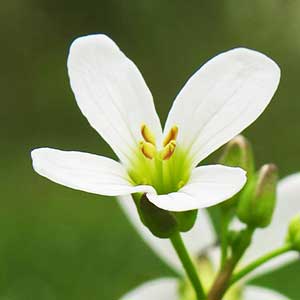Cardamine penduliflora
Cardamine blaisdellii
wetlands bitter-cress, Willamette Valley bitter-cress
(tuberiform, fragile), 4–9(–11) mm diam., (fleshy).
cylindrical, slender, 0.7–1.5 mm diam.
erect or decumbent at base, unbranched, 2–6(–7.5) dm.
erect or ascending, unbranched, 0.5–2(–2.5) dm.
5–13-foliolate, (4–)10–18(–25) cm, leaflets petiolulate or subsessile;
petiole (3–)5–12(–17) cm;
lateral leaflets subsessile, blade similar to terminal, sometimes smaller;
terminal leaflet (petiolule 0.4–0.7 cm), blade oblong to elliptic or ovate, (0.4–)0.7–1.7(–2) cm, base cuneate or obtuse, margins entire or obscurely 3-lobed.
pinnately 5- or 7-foliolate, 2.5–12 cm (not fleshy), leaflets petiolulate;
petiole 1.5–4(–9) cm;
lateral leaflets similar to terminal, or smaller and margins usually toothed, rarely entire;
terminal leaflet (petiolule 0.15–0.3 cm) blade suborbicular to broadly obovate, 0.4–1.5 cm × 2.5–14 mm, base obtuse to subcordate, margins 3–5-toothed, (apiculate).
2–6, 5–11-foliolate, petiolate, leaflets petiolulate or sessile;
petiole 3–10 cm, base not auriculate;
lateral leaflets sessile, blade similar to terminal, smaller;
terminal leaflet (petiolule 0.5–1.5 cm), blade narrowly ovate or oblong to oblanceolate, 1.5–3.5 cm × 2–15 mm, margins entire or toothed to 3-lobed.
1–3, (3–)5-foliolate (alternate), petiolate, leaflets petiolulate or subsessile;
petiole 0.2–2(–6.5) cm, base not auriculate;
lateral leaflets similar to terminal;
terminal leaflet subsessile or petiolulate (to 0.2 cm), blade obovate to oblanceolate, 0.5–1.5 cm × 3–10 mm, base cuneate, margins 3-toothed or entire.
ebracteate.
ebracteate.
sepals oblong to ovate, 3.5–5 × 1.8–2.5 mm, lateral pair saccate basally;
petals white, obovate, 12–16 × 6–8 mm, (not clawed, apex rounded or subemarginate);
filaments: median pairs 6–7 mm, lateral pair 4–5 mm;
anthers oblong, 1.5–1.8 mm.
sepals oblong, 2–3.5 × 2–2.5 mm, lateral pair slightly saccate basally;
petals white, broadly obovate, 7–10 × 3–6 mm (clawed, apex rounded);
filaments: median pairs 3–4 mm, lateral pair 2–3 mm;
anthers oblong, 1–1.5 mm.
ascending to divaricate, (10–)20–40(–60) mm.
erect to ascending, 0.7–22 mm.
linear, 2.5–4.5 cm × 1.4–2 mm;
ovules 12–24 per ovary;
style 4–6 mm.
linear, 1.6–4 cm × 1–1.3 mm;
ovules 14–24 per ovary;
style 0.7–3 mm.
brown, oblong, 1.8–2 × 1–1.5 mm.
brown, oblong, ca. 1.5 × 1 mm.
= 28, 42.
Cardamine penduliflora
Cardamine blaisdellii
Cardamine penduliflora is known from Douglas County north into Benton, Lane, Marion, Polk, and Yamhill counties.
(Discussion copyrighted by Flora of North America; reprinted with permission.)
Cardamine blaisdellii was treated by R. C. Rollins (1993) as a synonym of C. microphylla, but the morphological differences (see key) and molecular data (R. B. Jørgensen et al., 2008) clearly demonstrate that they are distinct.
(Discussion copyrighted by Flora of North America; reprinted with permission.)


